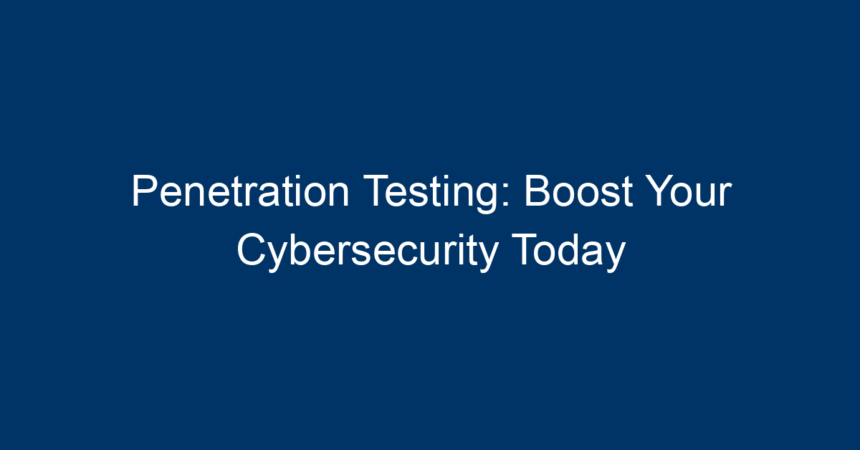In today’s ever-evolving digital landscape, cybersecurity has become an essential aspect of business operations. With the rise of cyber threats and data breaches, organizations are increasingly prioritizing their security measures. One of the most effective ways to strengthen your cybersecurity is through penetration testing. In this article, we will explore what penetration testing is, its importance, different types, and how it can significantly boost your cybersecurity posture.
What is Penetration Testing?
Penetration testing, often referred to as "pen testing," is a simulated cyber attack conducted on your systems, networks, or applications to identify vulnerabilities before malicious hackers can exploit them. Think of it as an authorized hack, where ethical hackers act as intruders, using the same methods as cybercriminals to discover weaknesses in your security.
The Goal of Penetration Testing
The primary goals of penetration testing include:
- Identify Vulnerabilities: Discover any security weaknesses that could be exploited by cybercriminals.
- Evaluate Security Measures: Assess the effectiveness of existing security protocols.
- Mitigate Risks: Develop strategies to eliminate or reduce identified vulnerabilities.
- Compliance: Ensure compliance with regulatory standards and industry best practices.
Why is Penetration Testing Important?
Proactive Security Measures
Many organizations adopt a reactive approach to cybersecurity, addressing threats only after they occur. Penetration testing flips this script by adopting a proactive stance. Identifying vulnerabilities before they can be exploited helps organizations act swiftly to mitigate risks.
Minimize Financial Loss
Data breaches can lead to significant financial repercussions, ranging from legal fees to loss of customer trust. According to IBM’s "Cost of a Data Breach" report, the average cost of a data breach in 2021 was $4.24 million. By investing in penetration testing, companies can minimize the financial risk associated with potential breaches.
Enhance Compliance and Reputation
Many industries have stringent compliance regulations regarding data security. Regular penetration testing helps organizations meet these requirements, avoiding heavy fines and maintaining a good reputation. Being transparent about your cybersecurity measures can also build customer trust.
Improve Security Awareness
When conducting penetration testing, organizations often discover flaws in their security policies or employee behavior. This knowledge can lead to enhanced training and awareness programs, fostering a more security-conscious culture within the organization.
Types of Penetration Testing
Understanding the different types of penetration testing can help organizations choose the right approach for their specific needs.
1. Network Penetration Testing
This type of testing evaluates the security of both internal and external networks. It aims to identify potentially exploitable vulnerabilities within servers, firewalls, and network devices. Network penetration testing is crucial for organizations that rely heavily on network communications.
2. Web Application Penetration Testing
Web applications are often targeted due to their accessibility and prevalence. This testing focuses on identifying weaknesses like SQL injection, cross-site scripting (XSS), and security misconfigurations in web applications. As businesses increasingly migrate online, this form of testing has become vital.
3. Social Engineering Penetration Testing
Social engineering involves manipulating individuals into revealing confidential information. This type of penetration testing assesses the human aspect of security by simulating phishing attacks or other deceptive tactics to gauge employee response.
4. Physical Penetration Testing
This less common but crucial type tests physical security measures. It attempts to gain unauthorized access to facilities, data centers, or server rooms, to evaluate the effectiveness of physical safeguards.
5. Mobile Application Penetration Testing
With the growing use of mobile applications, testing their security has become critical. This type of penetration testing focuses on identifying vulnerabilities specific to mobile apps, ensuring the protection of sensitive user data.
The Penetration Testing Process
Understanding the penetration testing process can demystify the concept and provide clarity on what to expect.
1. Planning and Reconnaissance
The first step involves defining the scope and rules of engagement. A clear understanding of organizational goals, assets to be tested, and parameters of the test will help in effectively planning the assessment. Reconnaissance involves gathering as much information as possible about the target systems, such as IP addresses and domain details.
2. Scanning
Once reconnaissance is complete, the next step is scanning the system for vulnerabilities. This involves using automated tools to detect open ports and services, which could serve as potential entry points for an attack.
3. Gaining Access
In this phase, ethical hackers exploit identified vulnerabilities to gain unauthorized access. They use a variety of hacking techniques, just as actual attackers would, to simulate real-world penetration.
4. Maintaining Access
After access is gained, the tester seeks to maintain that access for further exploration. This step helps in understanding how a real threat actor could persist within the system, often using techniques to ensure continued footholds.
5. Analysis and Reporting
Following the test, detailed reports are generated, outlining vulnerabilities found, data accessed, and the methods used. This analysis provides organizations with actionable insights to strengthen their security measures.
6. Remediation and Follow-Up
The last step involves addressing the vulnerabilities identified during the test. Organizations should prioritize remediation based on risk levels and conduct follow-up testing to ensure vulnerabilities have been effectively addressed.
Choosing the Right Penetration Testing Provider
Selecting the right provider is crucial for successful penetration testing. Here are some factors to consider:
1. Experience and Reputation
Research the provider’s history in the field. Check client testimonials and case studies to gauge their expertise.
2. Certification and Accreditations
Ensure the provider has certified specialists, such as Certified Ethical Hackers (CEH) or Offensive Security Certified Professionals (OSCP).
3. Customization
The provider should be willing to tailor their approach according to your organization’s needs. A one-size-fits-all approach may not yield the best results.
4. Comprehensive Reporting
Look for a provider that emphasizes detailed reporting and actionable insights, providing more than just a list of vulnerabilities.
5. Post-Test Support
The best providers offer ongoing support post-test to help you implement recommendations and ensure the security of your systems moving forward.
Conclusion: Actionable Insights for Your Cybersecurity Strategy
Penetration testing is not merely an IT task; it is a critical business strategy that can significantly enhance your organization’s security posture. As cyber threats evolve, so must your defenses. Here are some actionable insights to get started:
-
Conduct Regular Tests: Schedule penetration testing at least annually or whenever significant changes occur in your systems.
-
Involve All Departments: Security is a shared responsibility. Engage various departments in security awareness and training.
-
Use Findings to Improve: Regard penetration testing as an opportunity to learn and improve rather than just a compliance exercise.
-
Stay Informed: Keep abreast of the latest vulnerabilities and cyber threats affecting your industry.
- Invest in Security Tools: Beyond testing, consider investing in robust security tools to complement your cybersecurity strategy.
By integrating penetration testing into your cybersecurity framework, you not only protect your organization from potential attacks but also demonstrate to your clients and stakeholders that you take their security seriously. Start today, and make penetration testing a cornerstone of your cybersecurity strategy.




